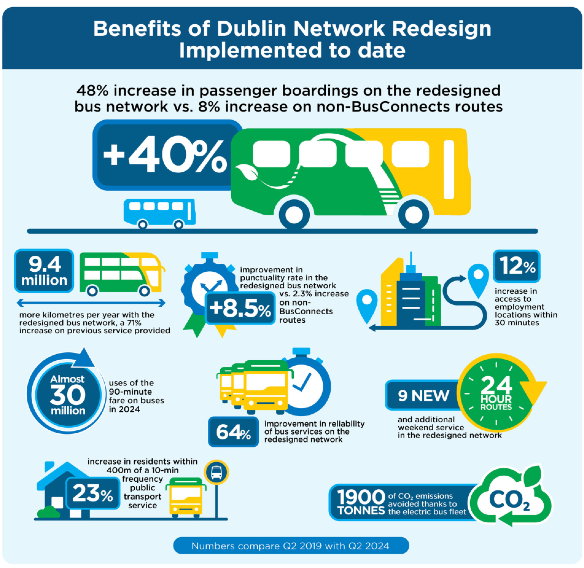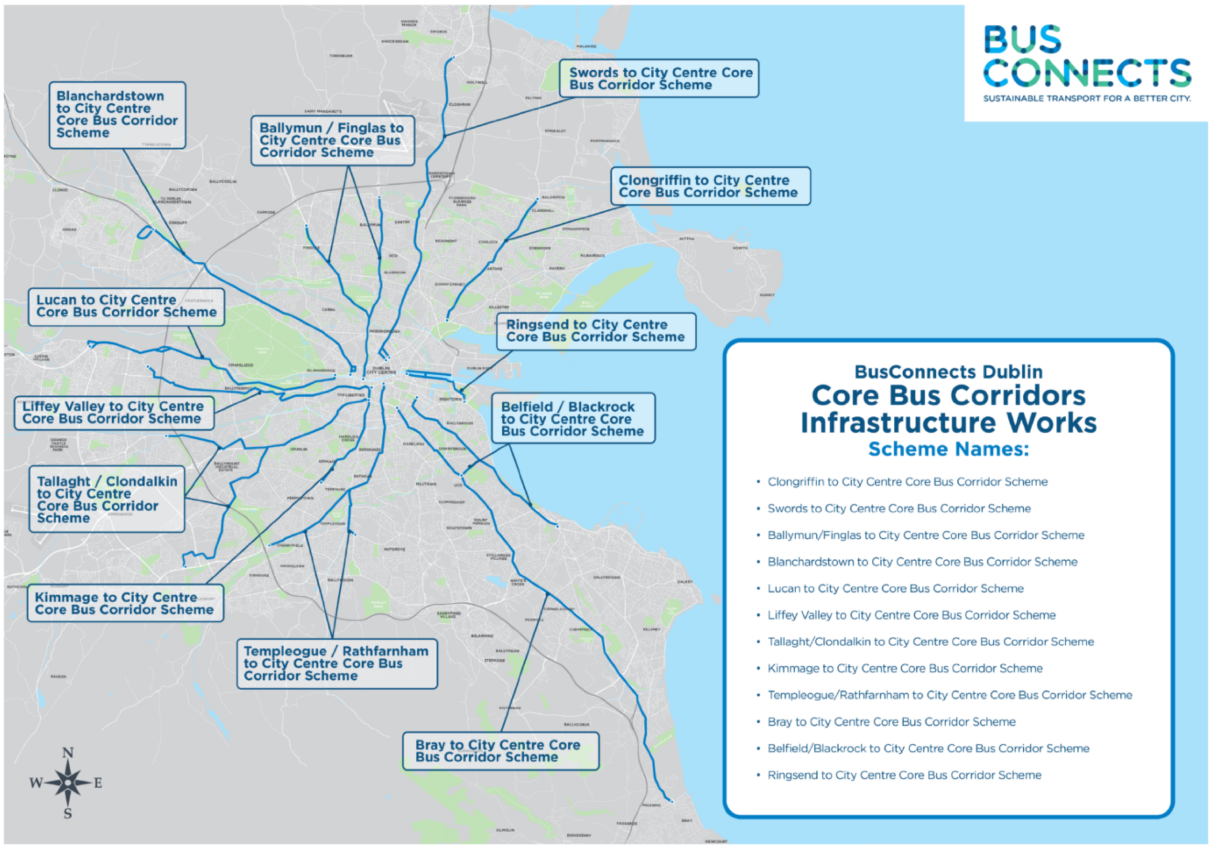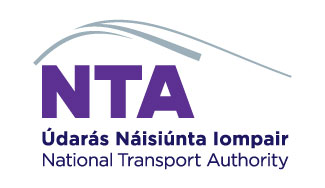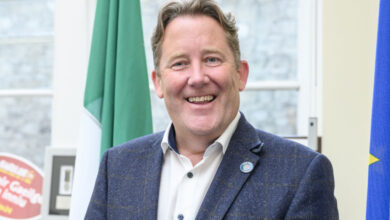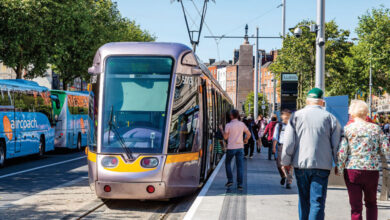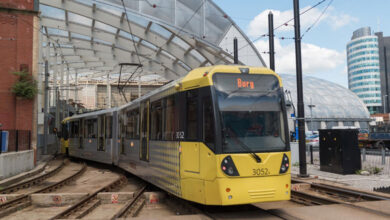BusConnects: From plan to progress
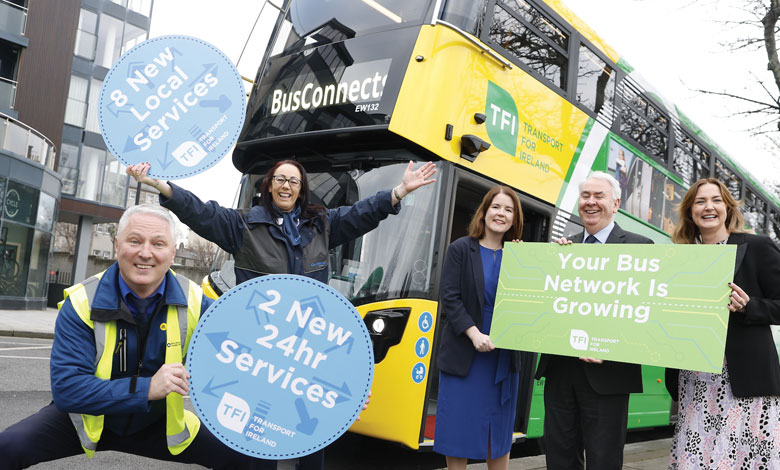
Last month NTA was notified that the Kimmage to city centre Core Bus Corridor (CBC) Scheme was granted planning approval by An Bord Pleanála. Reaching this milestone on the BusConnects Dublin infrastructure programme is a very positive development, writes NTA interim CEO, Hugh Creegan.
The approval by An Bord Pleanála of the final CBC Scheme is good news for bus customers, good news for sustainable transport and good news for the city. It is also welcome from a cyclist’s point of view, because in addition to 230kms of dedicated bus lanes there will also be over 200km of cycle tracks delivered across the 12 Schemes.
The scale and transformative potential of the BusConnects Programme reinforces its central role in influencing the future roadmap of Ireland’s transport system. It delivers on commitments within the National Development Plan 2021-2030, the Climate Action Plan 2025, the National Planning Framework 2040, the
Transport Strategy for the Greater Dublin Area 2022-2042 and other metropolitan area transport strategies. The BusConnects Programme is intended to fundamentally transform cities’ bus system so that journeys by bus will be fast, reliable, punctual, convenient and affordable. It will also transform cycling infrastructure by improving cycle facilities on key corridors, including providing segregated cycling routes and reducing the need to share limited road space directly with the improved bus services.
The programme encompasses a number of different projects including Core Bus Corridors (CBCs), the Network Redesign (NRD), Next Generation Ticketing (NGT) and fleet electrification.
The CBC project involves the development of continuous bus priority infrastructure and improved pedestrian and cycling facilities on key radial corridors across the Dublin region. Its vision is:
- to provide reliable and frequent bus services with improved cycling and pedestrian facilities;
- to connect people and places through expanded, integrated accessible sustainable transport system: and
- to enhance quality of life through a safer and greener transport system,
The granting of planning approval for the Kimmage CBC Scheme in May, really felt like the final hurdle had been overcome for BusConnects. It means that of the 12 Schemes that form the BusConnects Dublin infrastructure programme, all have now been given the planning green light.
While there are legal challenges against the approvals given by An Bord Pleanála for some Schemes. there is a significant number of Schemes which are clear from a planning and construction point of view. We are excited to get moving on these:
- Ballymun/Finglas;
- Liffey Valley;
- Ringsend;
- Tallaght/Clondalkin; and
- Lucan.
In the coming weeks, NTA will be announcing details of contracts for the construction of the first two Schemes, and by the end of the summer, there will be shovels in the ground as work gets under way in earnest. This key programme of investment in sustainable transport is finally moving from a design on a page to becoming a reality, and the benefits it confers on bus users and cyclists in communities across the city and beyond are about to become tangible rather than theoretical.
Benefits of core bus corridors:
• enhances the capacity and potential of the public transport system by improving bus speeds, reliability and punctuality through the provision of bus lanes and other measures to provide priority to bus movement over general traffic movements;
• supports the delivery of an efficient, low carbon and climate resilient public transport service, which supports the achievement of Ireland’s emission reduction targets;
• improves accessibility to jobs, education and other social and economic opportunities through the provision of improved sustainable connectivity and integration with other public transport services;
• enhances the potential for cycling by providing safe infrastructure for cycling, segregated from general traffic wherever practicable;
• enables compact growth, regeneration opportunities and more effective use of land in Dublin, for present and future generations, through the provision of safe and efficient sustainable transport networks; and
• ensures that the public realm is carefully considered in the design and development of the transport infrastructure and seek.
A new network of services
But other aspects of the BusConnects Programme are already bearing fruit and making a real difference for customers.
In June 2021, the first of 12 phases of NRD became a reality with the roll out of the H-spine serving communities from Howth and Malahide to Dublin’s city centre. In January 2025, new 24-hour services running between Bray, the city centre and Ballymun – the E1 and E2 – were introduced as part Phase 6a. Phase 7 will be rolled out later this year which includes the F-spine services running from Tallaght/Templeogue through the city centre and on to Finglas/Charlestown.
Customer response to the revised network has been very positive. Thanks to the new connectivity, improved frequency, and the expansion of the round-the-clock services, passenger boardings in areas covered by the new network are up by 40 per cent when compared to legacy routes. This is probably better than we expected, and has reinforced our view that the sooner we implement the remaining phases the better.
The overall objective is to provide a network that better meets the needs of the overall region and takes account of the growing population and changing travel patterns. Key characteristics of the new network include a simpler network centred on eight main Spines labelled A to H. The new network was redesigned to better meet the Dublin region’s needs by considering population growth and changing travel habits and offers more frequent services, particularly off-peak and at weekends, plus better coverage of the city, and for the first time, a proper network of orbital connections.
The redesigned network represents a major investment in enhanced bus services, delivering 71 per cent increase in scheduled service kilometres by the end of 2024. It also provides for a significant increase in overall capacity and better frequency for customers with more evening and weekend services. As well as this, nine new 24-hour routes have been launched so far as part of NRD.
Next generation ticketing
The ticketing systems on rail and bus are approaching the end of their useful life and require updating to a modern, faster and more efficient system. As part of the BusConnects Programme, a new ticketing system will be introduced which will incorporate the latest developments in account-based ticketing technology, including allowing use of credit / debit cards or mobile devices as a convenient means of payment. It will also enable more ticket choices, which cannot be currently provided in the existing system, as well as allowing faster introductions of fare alterations.
Following a highly competitive procurement process, in April 2024 the NTA awarded an overall framework contract for the design, supply, installation and operation of a new multi-modal ticketing system to a Spanish information technology company, Indra Sistemas SA, which has designed, installed, and operated similar systems internationally.
This large and complex technology project is now in the analysis and design phase and will take approximately three years to deliver.
Simpler fare structure
The previous ‘stage’ payment system that operated for the Dublin urban bus system has now been simplified with a new fares structure. The new fares structure was introduced in November 2021 and comprises of a short-distance fare on single leg journeys (approximately three kilometres or less) and a 90-minute fare that allows customers to seamlessly switch between any combination of Bus, DART/Commuter Rail and Luas services at no extra cost subject to commencing the last leg within 90 minutes of first boarding.
This new system has made movement between different modes and different services of the same mode easy and convenient and has introduced new journey possibilities for many people. As these new fares have been implemented in the last few years, the impact of the project is being continually assessed to determine if the anticipated benefits have been realised, including increase in LEAP card usage and public transport passengers. In 2024, the 90-minute fare was used 29.8 million times by bus passengers transferring from DART, Luas or another bus service within the preceding 90 minutes.
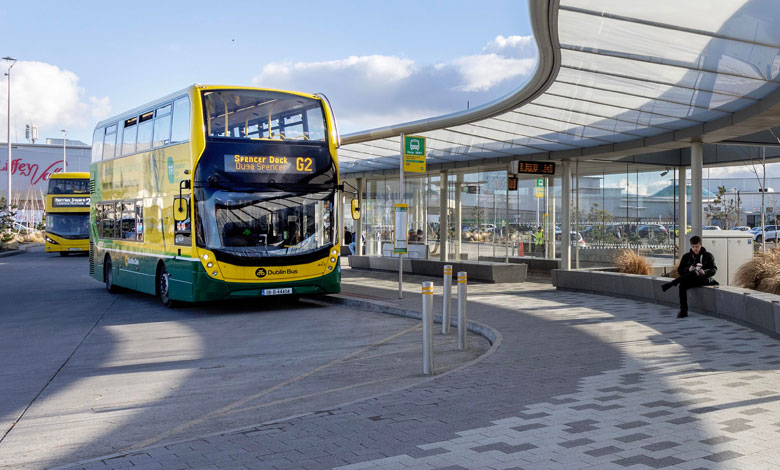
Transition to zero
BusConnects Dublin includes the transition to a zero-emission bus fleet to create a cleaner and more liveable city, contributing to the national priority to tackle climate change. The Transition to Zero Project also includes the electrification of existing bus depots and the construction of new depots to support operation of the fully electric fleet.
To date, the project has introduced 110 electric buses into service, with charging capacity in place in Summerhill and Phibsborough depots. In total, the electric bus fleet covered nearly 2 million kilometres in 2024. This led to approximately 1,900 tonnes of avoided CO2 emissions, when compared to the emissions of diesel buses travelling the same distance. This is enough to fill 383 Olympic-sized swimming pools with CO2.
Reducing CO2 emissions will play a significant role in advancing the decarbonisation efforts of public transport, aligning with the goals of the Climate Action Plan. The NTA intends that 85 per cent of the Dublin metropolitan area urban bus network will be operated by low and zero emission buses by 2032, and solely by zero emission buses by 2035.
A national programme
BusConnects is a national programme and its principles are applicable across the country. That is why there are BusConnects programmes, not just in Dublin, but in Cork, Limerick, Galway and Waterford.
In Cork, the new network was published in 2022, offering an overall 50 per cent increase in service levels; two 24-hour services, and seven all-day high-frequency routes. This is scheduled to be implemented from next year.
Another key component of BusConnects Cork is the implementation of bus priority measures through the development of Sustainable Transport Corridors along key routes into the city centre. This will remove buses from general traffic congestion and improve punctuality and reliability, which should also benefit other bus services operating across the Cork area. Three rounds of public consultation have been undertaken in relation to the proposed Sustainable Transport Corridors across Cork. Work is now ongoing to prepare the required statutory consent applications to An Bord Pleanála to be submitted on a phased basis from early 2026.
In Limerick, a new network was published in 2023 after a process of public consultation. This network will enable more people to avail of public transport resulting in increased access to a greater number of schools and workplaces across Limerick city. Overall service levels are to increase by about 70 per cent in the plan that will be implemented from 2027.
In Galway, a new network is scheduled for delivery in 2027. On the infrastructure side, the BusConnects Galway: Cross-City Link is being progressed by Galway City Council. This provide improved walking, cycling and bus infrastructure on this key access corridor in Galway City, which will enable and deliver efficient, safe, and integrated sustainable transport movement along the corridor.
The new BusConnects network for Waterford promising greater coverage and more services, will be implemented from 2027.
In conclusion, it is now clear that BusConnects is working. Passenger numbers are up thanks to the new network. The TFI 90-minute fare is now well embedded as part of the public transport experience. The process of modernising our ticketing system is under way. Emissions are reduced thanks to electrification. Ground is about to be broken on the CBCs.
There now can be no doubt that this kind of investment in bus services plays a vital role in providing a public transport system that is more useful, more affordable and more reliable for more people in more communities.
The broad geographical spread of BusConnects including the cities of Dublin, Cork, Limerick, Galway, and Waterford and the comprehensive approach of the Programme underscore its potential nationwide impact and demonstrate the concerted efforts of these regions in advancing sustainable urban mobility agendas.
NTA looks forward to the continued support at local and national level for the delivery of this crucial programme of investment.
T: +353 1 879 8300
E: info@nationaltransport.ie
W: www.nationaltransport.ie

